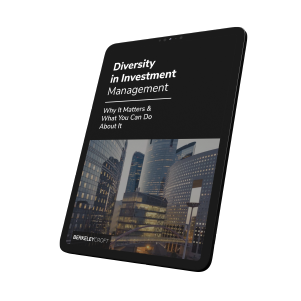
Diversity and inclusion is important to us at Berkeley Croft.
In recent years, the conversation surrounding diversity and inclusion as a whole has gained momentum. With the rise in prominence of the Black Lives Matter movement and the widespread discussions around the gender pay gap, we arguably live in a more progressive society than ever before.
However, that doesn’t mean we don’t still have a lot of work to do. In this post, we’ll provide an all-encompassing rundown of the state of diversity and inclusion within the Asset Management space, and what we can do collectively to improve it.
The state of diversity in the industry

Diversity and inclusion is an ongoing discussion in sectors across the board, but we do know that it has progressively become a significant talking point in the financial sector due to its reputation.
The predominately white, male-dominated industry, which is often slow to incorporate inclusive change, has sparked conversations regarding certain disparities in the workplace.
When comparing financial services to other industries like retail, leisure, and FMCG, the industry lags behind – and Asset Management is no exception. A senior financial regulator in the US admitted that the sector is “not doing a very good job” to improve diversity and inclusion. Clearly, something needs to change.
To take a step in the right direction, some leaders within the Asset Management industry needed to kickstart the process by overcoming certain factors that have previously let others fall behind on the D&I front. One of these factors is their general stubbornness to change. In remarkably homogeneous working environments, the necessity for a varied workforce amid reviewing existing employment policies can take a while to feature on the agenda. However, what some business leaders don’t realise is having a diverse workforce not only benefits employees and prospective candidates, but also their organisations. Diversity and inclusion gives businesses an edge.
While there has been some willingness to change and an increasing effort to resolve diversity inequalities, positive action on the inclusion side has sometimes fallen by the wayside.
Astute leaders within the Asset Management community recognise the importance of inclusivity, ensuring that no one feels alienated. Changes to the recruitment process and in-house amendments to accommodate neurodiverse individuals are examples of this.
Recognising the issues at hand is one thing for Asset Management leaders. Creating recruitment strategies that attract the best candidates, improve the business’ reputation, and ensure corporate success can be a considerable challenge. We recommend working with recruiters to help you do so successfully.
Read more about what Asset Management leaders are doing to enable D&I in the workplace.
Mind the (pay) gap
The gender pay gap is one area that the industry needs to examine closely if it’s going to seriously tackle diversity and inclusion within the financial sector, including the underrepresentation of women.
The gender pay gap in investment management is particularly worrying. It sits at around 30%, compared to a pay gap of around 14% in UK companies in other industries.
We know that it’s crucial for business growth, talent acquisition and retention that we welcome and nurture talent from diverse backgrounds and ensure it is properly integrated into our organisations, but in the UK, our efforts toward closing the gap between men and women are probably best described as “average”. The UK lies 20th in the Global Gender Gap Index, ahead of countries like Australia and Canada, but behind developing nations like the Philippines and Rwanda.
Despite efforts to attract more female candidates to the industry, little progress has been made in recent years. By the end of 2000, 14% of UK fund managers were women; fast-forward to the end of 2019 and that proportion was unchanged. Strikingly, there are more British funds run by men named David than by female fund managers.
It’d be easy to dismiss this as an issue with the wider finance industry, but once you look at the data, that argument just doesn’t stand. Indeed, across all financial and insurance-related activities in the UK, 44% of employees are women.
To tackle this issue head on, we need to understand why women are so underrepresented in Asset Management, and what we can do to change that. Ric van Weelden, a 30-year industry veteran, has conducted research on the matter; he found six key reasons behind the lack of female representation in the sector. We’ve written a blog that explains them all in detail.

What is unconscious bias?
One of the reasons for a lack of diversity in the workplace is a result of unconscious bias in the hiring process. Unconscious bias is defined as prejudice or unsupported judgments in favor of or against one thing, person, or group as compared to another, in a way that is usually considered unfair.
With technology becoming such an integral aspect of the finance industry, competition for digital skills is quickly having an impact on recruitment. By failing to recognise unconscious bias, organisations significantly reduce the talent pool that they hire from, and therefore put themselves at a disadvantage in key areas.
Recognising and understanding unconscious bias is key when attempting to improve diversity and inclusion in your organisation.
We’ve written a step-by-step guide so you know exactly where to start.

Is there a better approach?
The topic of diversity and inclusion is one that has cropped up several times throughout different industries in recent years. However, it seems that the conversation is starting to become repetitive.
Are we actually making headway in creating a more diverse and inclusive culture in Asset Management, or are we using buzzwords and vanity metrics to appear more progressive?
As an industry, we need to ensure that we’re not just having these conversations because we have to. It is that attitude towards diversity, equity and inclusion that has sparked discussions questioning whether it’s time to move forward with a different approach, namely belonging, dignity, and justice.
Reasons to support the new approach include the fact that diversity, equity, and inclusion implementation has become performative. It’s a way for businesses to appear to be doing the work to create a new culture, but ultimately, it’s not changing the lives of marginalised people working in these organisations.
The belonging, dignity, and justice approach is not just a tick-box exercise. Instead, it sets out to dismantle racism, dehumanisation, ableism, and sexism in the workplace through empathy and understanding, creating a place for marginalised people that is focused on their humanity rather than following strict corporate guidelines and requirements.
These are fundamental beliefs shared by a collective workforce – this is not a strategic approach to organisational change, but a cultural one. Read more about this potential new approach to diversity and inclusion by clicking below.
Conclusion
It’s fair to say that diversity and inclusion in Asset Management is definitely a work in progress. However, there have been some positive and encouraging signs that, as an industry, we are collectively on our way to really making a difference.
By recognising injustices such as the gender pay gap and understanding why they have emerged to implement hiring procedures that reduce the risk of unconscious bias, Asset Management and the finance industry will be well on their way to having a more diverse and inclusive workforce.
Changing the perception of what diversity and inclusion means can also be beneficial, with the belonging, dignity, and justice approach rewriting the narrative of D&I acting as a tick-box exercise in some organisations.

The aim of this approach is not financial gain, but rather to take a more focused approach to creating an ethical and empathetic working environment, which is likely to make employees happier and more productive. If you’d like more information on diversity and inclusion, check out our comprehensive eGuide.

